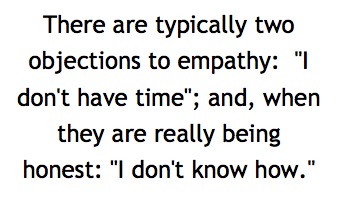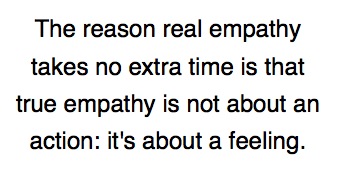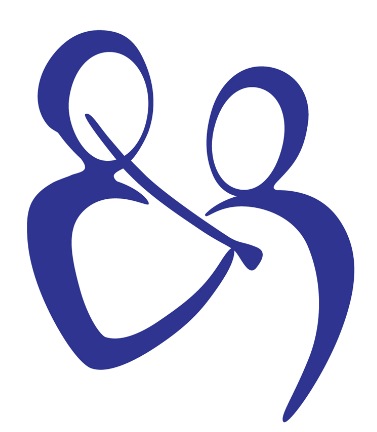
While medicine continues to advance, receiving healthcare as a patient is fundamentally a human process. At the center of effective care delivery is a connection between the provider and patient. Yet in the last 25 years many pressures have eroded the quality of this human-to-human healing connection. The good news is that in spite of all the external and very real pressures on the patient provider relationship, research reveals something many of us have known: Providers can learn fairly simple skills that make a large difference.
Many of us dream of a treatment context without escalating pressures, yet we’re probably better off facing reality. Even in the 1970’s when I was a new cardiac nurse, there was not enough time be present and listen while patients discussed their symptoms and fears. In recent years a growing population, the acuity of patients in many treatment settings, and a shrinking provider population has compounded this. Couple that with challenges brought on by insurance billing and electronic medical records and it’s clear why it’s so difficult for the provider and patient to have meaningful, connected conversations. While there is great uncertainty about the future of healthcare in the U.S., there is little doubt that time demands on providers will continue to increase, thus putting the patient provider relationship more at risk for diminishing satisfaction.
 Strengthening Connection
Strengthening Connection
Given this reality, the ability to efficiently and effectively connect with patients has become increasingly important. Fortunately, there are simple, practical skills available for providers to develop their ability to be present and listen while accomplishing their electronic health records functions and diagnosing. Just as medical professionals develop medical intelligence, providers must increase their emotional intelligence, thus closing the gap and promoting the human connection.
When I raise this topic with the physician and nurses I coach, there are typically two objections: “I don’t have time”; and, when they are really being honest: “I don’t know how.”
No Time for Empathy
Time pressure is intense. The financial reality of modern healthcare creates a relentless pressure to reach a swift diagnosis and treatment plan, to get the billing codes captured, and to move on to the next patient. These objectives are not conducive to empathy. Professionals often assume that empathy is a time-consuming exercise of drama and has little effect on ultimate health outcome: “If I show caring, the floodgates will open.” Recent research has shown surprising results, however: Empathic expression does not actually take more time if it is accomplished effectively[1][2][3].
In a fascinating study, researchers found that when discussing life-threatening diagnoses, patients offer many opportunities, or openings, for empathic response, and doctors respond to only 10% of these emotional needs. Surprisingly, “When empathy was provided, the responses from patients ranged from 1 to 2 words up to 1 sentence. On the other hand, we did notice that when empathy was not provided, some patients repeatedly attempted to have these needs addressed by creating additional empathic opportunities” [1]. In other words, empathic response may actually save time, and this finding appears in other studies as well [2][3].
Developing Empathy Skills
In terms of skill, it’s easy to understand that medical, and other professionals have focused on technical knowledge. This has become the norm for those steeped in the Scientific Method. They are not generally selected and trained for emotional intelligence, and in fact, little time is spent during medical training on connecting with the patient. These are, however, learnable skills [4]. The most important step in that learning is a connection between provider and patient that can increase healing and decrease time spent.
Let me share a story about connection that stands out. At seven years old, my twin granddaughters are extremely distressed when encountering dogs, to the point of phobia. While they were visiting recently during winter break, just after I gave my husband a new puppy, we had the opportunity to introduce them gently and positively to the presence of the dog.
 We were very careful to keep the dog in his pen. On New Year’s Eve, while we were enjoying a celebratory evening, the dog was crying. A moment of connection occurred, and one of the girls, full of fear, but equally full of compassion, turned to me and said, “Let’s let him out of the pen.” This event opened up a world of learning about the positive effects of dogs for both girls.
We were very careful to keep the dog in his pen. On New Year’s Eve, while we were enjoying a celebratory evening, the dog was crying. A moment of connection occurred, and one of the girls, full of fear, but equally full of compassion, turned to me and said, “Let’s let him out of the pen.” This event opened up a world of learning about the positive effects of dogs for both girls.
Likewise, it’s scary to “let the dog out” and enter into an unknown way of interacting. Giving oneself permission to actually feel the empathic connection – the care in healthcare – is the secret to achieving this step. It’s not about a particular set of words or a way of sitting, or a formula of how to touch a patient’s hand. The reason real empathy takes no extra time is that true empathy is not about an action: it’s about a feeling.
More and more research is emerging to show that using skills such as empathy not only reduces patient anxiety, but also improves clinical outcomes [5] and reduces malpractice claims [6]. The data is compelling, but what’s convinced me is the real world experience. In emotional intelligence training, I’ve watched doctors and nurses overcome their fears, connect with their own emotions, and genuinely connect with others. My hope is that all of us, professionals, patients, friends and family, will remember that we have the fundamental ability to connect, to experience what it means to be fully human, to care – and this caring is ultimately both simple and profound.
References
[1] Morse DS, Edwardsen EA, Gordon HS. Missed Opportunities for Interval Empathy in Lung Cancer Communication. Arch Intern Med. 2008;168(17):1853-1858. doi:10.1001/archinte.168.17.1853. http://archinte.jamanetwork.com/article.aspx?articleid=414476#ref-ioi80080-2
[2] Roter DLHall JAKern DE et al. Improving physicians’ interviewing skills and reducing emotional distress: a randomized clinical trial. Arch Intern Med 1995;155 (17) 1877- 1884
[3] DiMatteo, M. Robin; Hays, Ron D.; Prince, Louise M. Relationship of physicians’ nonverbal communication skill to patient satisfaction, appointment noncompliance, and physician workload. Health Psychology, Vol 5(6), 1986, 581-594. doi: 10.1037/0278-6133.5.6.581
[4] Fariselli et al (2006). Increasing Emotional Intelligence, staging.6seconds.org/tools/sei/research
[5] Canale, Stefano Del MD, PhD; Louis, Daniel Z. MS; Maio, Vittorio PharmD, MS, MSPH; Wang, Xiaohong MS; Rossi, Giuseppina MD; Hojat, Mohammadreza PhD; Gonnella, Joseph S. MD (2012) The Relationship Between Physician Empathy and Disease Complications. Academic Medicine.
[6] Physician-Patient Communication: The Relationship With Malpractice Claims Among Primary Care Physicians and Surgeons, Levinson et al (1997) JAMA. 1997;277:55.3-M9
- Enhance Emotional Literacy - July 13, 2023
- Plutchik’s Wheel of Emotions: Feelings Wheel - March 13, 2022
- Technology Loneliness: EQ Tips from Daniel Goleman - October 24, 2020



What an important endeavor to promote the human dimensions of care through shared values! It’s great to know about your work. Thank you
Thank you for your insightful article. With today’s healthcare economics and focus on throughput rather than on the human aspects of care, we have lost much empathy. Thank you for pointing out that empathy can actually increase efficiency and save time.
Empathy, compassion, dignity, respect, integrity and other values are essential to the practice of safe and ethical care.
Several years ago, we established an international collaborative effort to identify and promote the human dimensions of care – starting with Compassion. This effort has resulted in the International Charter for Human Values in Healthcare. The mission of the International Charter for Human Values in Healthcare is to restore universal core values that should be present in every healthcare interaction to healthcare around the world. We’ve been working hard in research, education and practice areas to enhance compassion, relationships and healing in healthcare. Healthcare organizations are joining us as partners in this work. We welcome all in this important work! http://charterforhealthcarevalues.org
Colette – really marvelous article. We in healthcare need so much to learn that “healing” is not in medicine, but in connecting and caring, in leading to hope, and to ways people can move towards the healing that is within. And the first step I think is to be heard and really cared about. I still struggle with hearing and caring, and not being disrespectful to other patients who are waiting for their appointments – because there truly are lots of time pressures. Yet – the “holy space” is the face-to-face encounter with that person. Thanks for putting your insight out there and starting the conversation.
Thank you, Colette, for this very interesting article. In couple years your granddaughters may learn that our little friends are capable of empathy too. For example, seeing your dog putting its head on your lap and looking at you with sad eyes or licking your hands when you are in pain or distress. And this is the pet you have the strongest connection with. We, human beings, are capable of expressing empathic thoughts in diverse ways. Lets use the gift more for the good.
Yes, we are learning so much about empathic connection and animals. I have learned already how tuned in our little dogs are to our moods!
Colette, I love this comprehensive overview on such an important topic, and your dog example.
We’ve heard that doctors famously interrupt their patients within 18 seconds of the patient’s opening story. Yet as Dr. Iona Heath writes in the journal ‘Medical Humanities”, if doctors do actually listen to patient’s entire opening statement, it would take just 28.6 seconds.
Dr. Jack Coulehan, author of “The Medical Interview: Mastering Skills for Clinical Practice”, calls a health care provider’s failure to really listen “narrative incompetence”.
I was especially interested to read in your post: “When empathy was not provided, some patients repeatedly attempted to have these needs addressed by creating additional empathic opportunities”, which confirms our suspicion that non-empathetic responses do NOT save time at all, but may actually drag out the entire interaction.
My favourite empathy lesson goes back decades to a day when I cut my thumb while chopping veggies with a brand new and surprisingly sharp knife (stay with me – I do have a point here!)
Later that night when I was changing the dressing, I showed this cut to my husband, who (probably in a misguided attempt to take my mind off it or cheer me up!?) responded: “Oh, it doesn’t look that bad!”
“Not that bad?” I shrieked. “NOT THAT BAD?!?! What do you mean “NOT THAT BAD?!” It’s horrible! Look closer at this! Look how BAD this really is!” – in a spirited defense of my own tragedy that went on far too long – trying to somehow ‘prove’ to him the seriousness of what I was experiencing.
But contrast that with the immediate reaction of my mother-in-law, who happened to be in the kitchen with me earlier when I had cut that thumb. Her response was swift and entirely empathetic: “Oh, my!! That looks very painful. Maybe we should go to Emerg – you might even need stitches!”
To which I answered: “No, it’s okay – it’s not that bad!” I didn’t have to ‘prove’ anything to her, as I knew instantly that she ‘got it’.
Emerging studies on doctor-patient communication merely confirm what my mother-in-law has always known. More on Dr. Coulehan’s work on “narrative incompetence” at: http://myheartsisters.org/2013/03/22/not-listening-narrative-incompetence/
I agree with empathy being a two way path, as a nurse in the ICU. However, it is very understandable that the patient & family member has been thrust into a setting that is generally completely out of their environment and can be so over whelming. Having empathy for the caregiver, the staff, is not very reasonable. I know I would settle for them just being nice. It’s my job as caregiver to have empathy. I know when I show my patients and family members empathy it can change the whole path or situation for the paatient. True empathy really is a game changer and changes the way in which communication takes place. Thanks for your very timely message.
Judy, As an ICU nurse you have likely seen so many ways that “true empathy really is a game changer.” Such a powerful metaphor and that prompts me to ask if you would consider sharing a story. Fron all of your experiences, can you describe a time that stands out for you when empathy was a true game changer in your work with patients and their families, a time when empathy made a profound and positive difference. Some additional questions to consider; what was the situation, who was involved, how did empathy change the game? Look forward to your response!
Judy, just realized I had a story to share with you about empathy for providers. Yes, I completely agree, patients are in in the hospital especially the ICU because they have been thrust into a crisis situation. I understand that now better than ever before as my young (it’s all relative) and otherwise healthy husband had a cerebellar stroke in the fall and was rushed to the ER. We never imagined it was a stroke. The day after he was admitted to the hospital the neurologist who had spent the night before in ER was making rounds. My husband and I expressed genuine concern for her as she looked quite tired. In doing so I noticed our connection grew and we all relaxed more. We were human, she was human and we were all exhausted. Seemed so simple to notice and express concern and somehow connected us. I’d not thought of that situation until reflecting on the notion of caring for your provider. If and when it’s possible to “walk in the provider’s shoes” I wonder if it’s not just good medicine for all! She ended spending hours in his room over the course of my husbad’s hospitalization.
Judy – just wanted to say THANK YOU for this comment, but mostly for practicing EQ in your day-to-day. I imagine it’s not always easy in the intensity of ICU.
This is an excellent blog – thanks very much for sharing! I would very much appreciate the opportunity of getting to know your work.
I am a UK psychiatrist interested in a public health approach to suicide and self harm prevention in addition to promoting compassion in healthcare and to this end developed the ‘Connecting with People’ emotional resilience, suicide awareness and compassionate care training, which is now available nationally throughout the UK. My colleagues and I have also recently developed training to enhance emotional literacy and resilience.
Please find a link to our website below. Joshua has kindly agreed to include one of our projects U Can Cope as part of the six second’s week:
http://www.connectingwithpeople.org/
U Can Cope film and coalition:
Samaritans, the Royal College of Psychiatrists, Connecting with People training and Southwick Media Consultancy have produced the film ‘U Can Cope’ – formally endorsed by the International Association of Suicide Prevention Suicide and the Media Task Force. U Can Cope focuses on three people for whom life had become unbearable but who, after seeking help, are now leading happy lives.
The film promotes 3 main messages: Anyone can experience suicidal thoughts, there is always hope, there is always help
U can Cope Film and all resources available:
http://www.connectingwithpeople.org/ please follow this link to view the U Can Cope film and the 3 resources
U Can Cope also highlights the new Royal College of Psychiatrists’ resources: http://www.rcpsych.ac.uk
Developed by Connecting with People and collaborators have on behalf of the RCPsych:
• Feeling on the edge helping you get through it – for people in distress attending the Emergency Department following self harm or with suicidal thoughts.
• Feeling overwhelmed and staying safe and for anybody struggling to cope when bad things happen in their life. Explains clearly and simply how to make a ‘safety plan’.
• U Can Cope designed to help young people develop resilience and cope with any current/future difficulties in their life. Just as helpful for adults.
Thanks again for your excellent piece.
Alys, thank you so much! What important work you’re doing and the video and web site are outstanding. Such an important area. Utah, the state I reside, has a very high rate of male teenage suicides. I’m going to share your information with a psychiatry group I’ve consulted with the last year on innovation, collaboration and strategic planning.
Just saw this video from the Cleveland Clinic about empathy & care — good reminder. http://youtu.be/cDDWvj_q-o8
Colette, Amazing work you are doing and spreading the message to so many. This arena touches us all and your reference to the humaness that we all share reminds us of the role we each play. My father-in-law just returned home after a three-week stay including emergency care, ICU, and eventually a rehab hospital. One interesting thing my husband and I noted along this path was that the patient needs to have empathy for the providers as well! It does go both ways. When each side is empathetic what a change we see in our world. Also true for family members of the patient and beyond. This goes for all our human interactions. What delight that your grandchildren and your two new canine family members are continuing to reinforce what you already knew to be true! Thank you for touching the world with all that you are!
Jeanne, wow, what an important observation you’ve made with your father-in-law’s hospitalization and how important it is for empathy to go both ways. Can’t you just imagine a hospital campaign promoting, “got empathy” it’s good medicine for all! Care for your care provider as your provider cares for you. Heartfelt appreciation for connecting and your insightful, kind words!
Collette, This article is so timely. We were just talking about this same subject in our provider meeting this week. I know that compassionate care goes a long way, especially with our homeless patients. I will forward this to our providers as I know they will find it valuable.
It was such a delight seeing you at our CAN event. I always enjoy catching up with you and Allan. Thank you both for making it a priority to attend. We are forever grateful for the wonderful organization Allan founded.
Collette, Thanks for bringing this topic to the table. We all work to improve outcomes and engage our teams. This should be our greatest focus. Relationships define humanity … connecting with others is the basic ingredient of life. While empathy and connecting with our patients may reduce anxiety and even elevate the healing experience, they benefit the provider as well. I challenge anyone to find meaning in their work with patients without opening themselves to true caring through empathy and human connection. It is rejuvenating and energizing! Thanks for the thought-provoking article.
Todd, how beautifully stated and so appreciate the point you make about the relationship between meaning and empathy.
Thanks for a wonderful article. Spending lots of time with my parents, dad in assisted living and mom in hospice, I see the value of empathy in care. Luckily, both parents get a decent amount of it. I hope the reminder of this article will help me interact better with them as well.
Colette, This article is of unique interest to me. I believe that empathy can be a catalyst for promoting intrinsic motivation in a health care setting. The human connection can be a powerful and rewarding experience that can encourage employees to seek out similar experiences over and over again. I believe we are putting too much attention on training and carrots and sticks in our efforts to improve patient satisfaction and not enough on encouraging empathy based experiences which I believe can be a critical factor in providing the intrinsic motivation needed for an honest patient connection. Those connected experiences are the foundation for positive patient experience on a number of levels. You may be interested in a video which is grounded on the topic expressed in your article. You can find it at http://linchpin-marketing.com/post/182 Thanks again for your very relevant topic.
Pete,Thanks for your comments and sharing your inspiring and important video. Yes, when providers from the “inside-out” embody the “care in caring” the connection is so mutually life-enhancing. Those moments accumulate in the life a health care provider. I will be forever grateful for how the provider-patient relationship shaped my life in profound and powerful ways.
I think the “let the dog out” story is a good example of this link between Exercise Empathy and Engage Intrinsic Motivation.
I like the simplicity of the presentation of this truth of life about how easy it is for one to show empathy if one really wants to. Colette, you have opened topic which is among the major victims of our time ‘Empathy’. With the craze to achieve more in no time, make more money, technically reach out more people……we have become very Transactional than real. A simple touch of a healthcare giver on a patient, except for the point of pain lives a greater healing effect on the patient than all the medicines put together.
Debbie, yes a “simple touch” in a millisecond, may impact both patient and provider. Authentic presence has mutual benefits.. and transcends time!